East London, Eastern Cape
East London (Xhosa: eMonti; Afrikaans: Oos-Londen) is a city on the southeast coast of South Africa[3] in the Buffalo City Metropolitan Municipality of the Eastern Cape province. The city lies on the Indian Ocean coast, largely between the Buffalo River and the Nahoon River, and hosts the country's only river port. As of 2011, East London had a population of over 267,000 with over 755,000 in the metropolitan area.[4]
East London | |
|---|---|
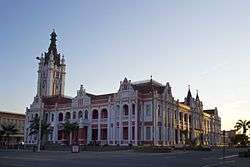 East London City Hall | |
 East London 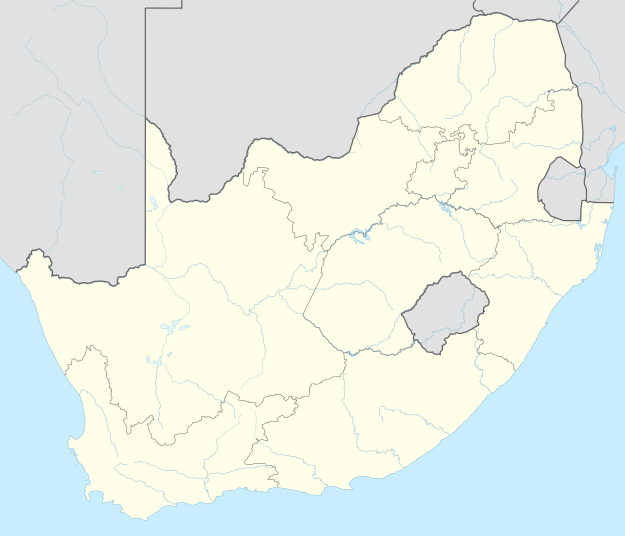 East London 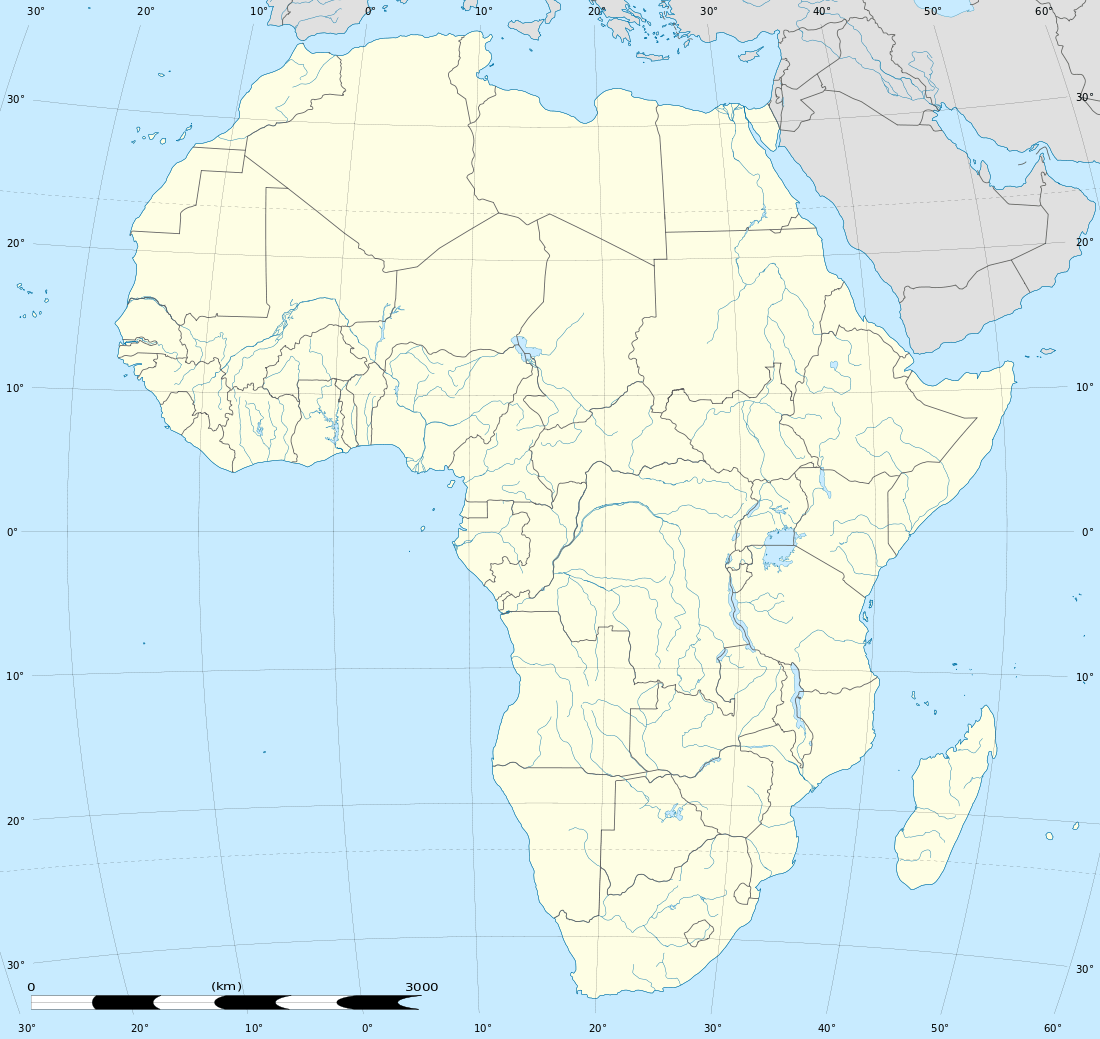 East London | |
| Coordinates: 32°59′S 27°52′E | |
| Country | |
| Province | Eastern Cape |
| Municipality | Buffalo City |
| Established | 1847[1] |
| Area | |
| • City | 168.86 km2 (65.20 sq mi) |
| • Metro | 2,536 km2 (979 sq mi) |
| Population (2011)[2] | |
| • City | 267,007 |
| • Density | 1,600/km2 (4,100/sq mi) |
| • Metro | 755,200 |
| • Metro density | 300/km2 (770/sq mi) |
| Racial makeup (2011) | |
| • Black African | 70.1% |
| • Coloured | 11.6% |
| • Indian/Asian | 1.8% |
| • White | 16.0% |
| • Other | 0.5% |
| First languages (2011) | |
| • Xhosa | 61.8% |
| • English | 21.2% |
| • Afrikaans | 13.3% |
| • Other | 3.8% |
| Time zone | UTC+2 (SAST) |
| Postal code (street) | 5200 |
| PO box | 5201–5499 |
| Area code | 043 |
| Website | eastlondon.org.za |
History
Early history
John Bailie, one of the 1820 Settlers, surveyed the Buffalo River mouth and founded the town in 1836. There is a memorial on Signal Hill commemorating the event.[5] The city formed around the only river port in South Africa and was originally known as Port Rex. Later it was renamed London in honour of the capital city of Great Britain, hence the name East London. This settlement on the West Bank was the nucleus of the town of East London, which was elevated to city status in 1914.
During the early to mid-19th century frontier wars between the British settlers and the local Xhosa inhabitants, East London served as a supply port to service the military headquarters at nearby King William's Town, about 50 kilometres (31 mi) away. A British fort, Fort Glamorgan, was built on the West Bank in 1847, and annexed to the Cape Colony that same year. This fort is one of a series of British-built forts, including Fort Murray, Fort White, Fort Cox, Fort Hare, Fort Jackson and Fort Beaufort, in the border area that became known as British Kaffraria.
With later development of the port came the settlement of permanent residents, including German settlers, most of whom were bachelors. These settlers were responsible for German names of some towns in the vicinity of East London such as Stutterheim and Berlin. Today, German surnames such as Gehring, Salzwedel and Peinke are still common in East London, but the descendants of the settlers rapidly became Anglicised.
The existing port, in the mouth of the Buffalo River, adjoining the Indian Ocean, began operating in 1870. In 1872, the Cape Colony, under the leadership of its first Prime Minister John Molteno, attained a degree of independence from Britain. The new government merged the three neighbouring settlements of East London, East London East and Panmure in 1873, forming the core of the current municipality, and in 1876 it began construction on the region's railway lines, commencing on the river's east bank. At the same time, it began construction of the East London harbour. This new infrastructure rapidly accelerated development of the area into today's thriving city of East London.[6][7]
The unusual double-decker bridge over the Buffalo River was completed in 1935, and to this day is the only bridge of its type in South Africa. Modern day attractions include the Gately House, City Hall, Cape Railways, Nahoon Museum, East London Museum housing the coelacanth, a prehistoric fish, thought to be extinct, discovered live at the Chalumna River mouth near East London by fishermen in 1938,[8] and numerous memorial statues.
Apartheid era
In 1948 the National Party came to power in South Africa, and began to implement the policy of apartheid. Apartheid as a doctrine envisaged the total segregation of races in South Africa, and East London was no different. In 1950, the Group Areas Act was placed upon the statute books making absolute segregation in all urban areas mandatory. In 1951, the Land Tenure Advisory Board, the body created to enforce the act, conducted initial investigations into the reallocation of space along racial lines in East London. Residential segregration had long been practised in East London prior to the advent of apartheid. In 1941, the East London Municipality moved residents from East Bank townships to the newly built township of Duncan Village.[9]
In 1951, all inter-racial property exchanges were prohibited in East London. In 1955, the Amalinda area was zoned as a White Group Area by Government Gazette Proclamation number 21. This meant that the municipality's plans to extend the area in order to accommodate the black African population were abandoned.[9] In 1953, residents in the East Bank were forcibly moved to the new township of Mdantsane.[10] In February 1966, the apartheid South African government defined Mdantsane as a separate homeland township. In 1956, South African President Henrik Verwoerd, who was the archarchitect of apartheid, forbade the East London municipality from extending the existing Duncan Village township and sanctioned the building of Mdantsane.[9]
In 1961, these plans provided for the allocation of a distinct wedge of the city for Asian and Coloured residence, which "incorporated the areas of North End and the recently proclaimed Buffalo Flats location. This plan occasioned tremendous resentment in the city prompting petitions and letters of complaint from numerous organisations including the Black Sash, trade unions and various black community groups. In 1967, the East London Municipality proclaimed the majority of the city an area for white occupancy, with the exception of a broad sector of land encompassing the Parkside, Parkridge and Buffalo Flats areas which was zoned for coloured residence. Certain parts of Duncan Village were disestablished and its African residents removed, new coloured and Asian locations were built and proclaimed upon land in 1973. In the same year, the newly constructed location of Braelynn was proclaimed an Indian area while Buffalo Flats Extension and Pefferville were proclaimed as coloured areas. The construction/ extension of coloured areas and the Duncan Village were suspended in 1983.[9]
Post-apartheid
At the end of apartheid in 1994, East London became part of the province of Eastern Cape. In 2000, East London became part of Buffalo City Metropolitan Municipality, also consisting of King William's Town, Bhisho and Mdantsane and is the seat of the Metro.
Geography and climate
| East London | ||||||||||||||||||||||||||||||||||||||||||||||||||||||||||||
|---|---|---|---|---|---|---|---|---|---|---|---|---|---|---|---|---|---|---|---|---|---|---|---|---|---|---|---|---|---|---|---|---|---|---|---|---|---|---|---|---|---|---|---|---|---|---|---|---|---|---|---|---|---|---|---|---|---|---|---|---|
| Climate chart (explanation) | ||||||||||||||||||||||||||||||||||||||||||||||||||||||||||||
| ||||||||||||||||||||||||||||||||||||||||||||||||||||||||||||
| ||||||||||||||||||||||||||||||||||||||||||||||||||||||||||||
East London has an oceanic climate (Köppen Cfb), bordering on a humid subtropical climate (Köppen Cfa), with the warm temperatures and moderation typical of the South African coastline. Although it has no true dry season, there is a drying trend in the winter, with the wettest times of year being spring and autumn. There is also a shorter and lesser dry period in December and January.
The all-time record low is 3 °C (37.4 °F), and the all-time record high is 42 °C (107.6 °F). The hottest temperatures have been recorded in springtime, rather than the summer months. Temperatures above 38 °C (100 °F) have only been recorded early in the season, from August to December. Berg winds contribute to these high temperatures, as already warm air from the arid interior is further heated through compression as it drops over the escarpment to sea level. Although temperatures have never dropped below freezing since records began, East London has recorded snowfall in 1985 and 1989.[12]
| Climate data for East London (1961–1990, extremes 1939–1990) | |||||||||||||
|---|---|---|---|---|---|---|---|---|---|---|---|---|---|
| Month | Jan | Feb | Mar | Apr | May | Jun | Jul | Aug | Sep | Oct | Nov | Dec | Year |
| Record high °C (°F) | 36.4 (97.5) |
42.6 (108.7) |
38.6 (101.5) |
35.9 (96.6) |
37.0 (98.6) |
32.8 (91.0) |
34.3 (93.7) |
37.5 (99.5) |
41.7 (107.1) |
40.9 (105.6) |
40.3 (104.5) |
38.2 (100.8) |
42.6 (108.7) |
| Average high °C (°F) | 25.6 (78.1) |
25.7 (78.3) |
25.0 (77.0) |
23.7 (74.7) |
22.6 (72.7) |
21.1 (70.0) |
20.9 (69.6) |
21.0 (69.8) |
21.0 (69.8) |
21.5 (70.7) |
22.7 (72.9) |
24.5 (76.1) |
22.9 (73.2) |
| Daily mean °C (°F) | 21.6 (70.9) |
21.6 (70.9) |
20.8 (69.4) |
18.9 (66.0) |
17.1 (62.8) |
15.4 (59.7) |
15.1 (59.2) |
15.4 (59.7) |
16.3 (61.3) |
17.2 (63.0) |
18.7 (65.7) |
20.4 (68.7) |
18.2 (64.8) |
| Average low °C (°F) | 18.4 (65.1) |
18.5 (65.3) |
17.7 (63.9) |
15.2 (59.4) |
12.8 (55.0) |
10.7 (51.3) |
10.3 (50.5) |
10.9 (51.6) |
12.4 (54.3) |
13.9 (57.0) |
15.5 (59.9) |
17.0 (62.6) |
14.4 (57.9) |
| Record low °C (°F) | 9.0 (48.2) |
11.0 (51.8) |
10.3 (50.5) |
7.2 (45.0) |
4.4 (39.9) |
2.6 (36.7) |
1.8 (35.2) |
3.1 (37.6) |
5.0 (41.0) |
5.9 (42.6) |
8.5 (47.3) |
8.4 (47.1) |
1.8 (35.2) |
| Average precipitation mm (inches) | 69 (2.7) |
92 (3.6) |
105 (4.1) |
83 (3.3) |
52 (2.0) |
40 (1.6) |
47 (1.9) |
78 (3.1) |
80 (3.1) |
102 (4.0) |
110 (4.3) |
63 (2.5) |
921 (36.3) |
| Average precipitation days (≥ 1.0 mm) | 9 | 9 | 9 | 7 | 5 | 4 | 3 | 5 | 7 | 9 | 9 | 8 | 84 |
| Average relative humidity (%) | 80 | 82 | 82 | 78 | 72 | 66 | 67 | 71 | 77 | 78 | 80 | 80 | 76 |
| Mean monthly sunshine hours | 220.5 | 191.7 | 204.0 | 219.3 | 227.3 | 221.1 | 236.6 | 234.0 | 205.7 | 208.5 | 215.6 | 239.7 | 2,624 |
| Source 1: NOAA,[13] Deutscher Wetterdienst (extremes)[14] | |||||||||||||
| Source 2: South African Weather Service[11] | |||||||||||||
Economy
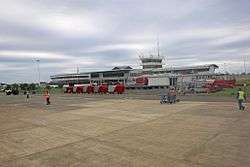
East London is the second largest industrial centre in the province. The motor industry is the dominant employer. A major Daimler plant is located next to the harbour, manufacturing Mercedes-Benz and other vehicles for the local market, as well as exporting to the United States and Brazil. Other industries include clothing, textiles, pharmaceuticals and food processing.
The period of international sanctions that followed in the 1980s damaged the economy of East London's harbour. Enormous investment in recent years, by corporations such as Daimler AG, has resulted in the harbour being developed to include a new car terminal.
From the 1960s until the 1990s, the apartheid government created tax and wage incentives to attract industries to the then black "independent states", including nearby Ciskei. Investment thus flowed into surrounding areas such as Fort Jackson and Dimbaza, leaving East London in relative isolation. Transport infrastructure deteriorated and port activity wound down.
To encourage investment in East London, the East London Industrial Development Zone (IDZ) was established on the West Bank in 2004, close to both the port and airport. 1500ha of land has been made available, and the site is one of four duty-free development areas in South Africa.
Sports
Cricket is very popular around East London. A combined Border/Eastern Province cricket side known as the Warriors take part in the top provincial competition. Former Proteas wicketkeeper Mark Boucher who currently holds the Test record for most dismissals by a wicketkeeper hails from East London. Buffalo Park Stadium in East London hosted a match during the ICC Cricket World Cup in 2003 and two matches of the 2009 Indian Premier League.
The Buffalo Road Running Club of East London has created two established events that have gained international recognition. They are the Old Mutual Buffalo 42,2 km marathon, which is held in February/March each year, and South Africa's oldest 160 km extreme ultra marathon, the Washie, over a picturesque and undulating coastal route from Port Alfred to the city.
Triathlon is a popular sport and in particular the world-famous Ironman 70.3 South African event that takes place annually in January. Ironman 70.3 consists of a 1.9 km swim, 90 km of cycling and a 21.1 km road run. The event starts and finishes at Orient Beach in East London.
Rugby is popular in East London. The provincial team, the Border Bulldogs, currently plays in the First Division of the Currie Cup competition. Most national games in East London are played at the Buffalo City Stadium, which holds around 15000 people and was a host stadium during the 1995 Rugby World Cup. East London schools have produced many fine rugby players, including (in recent times) André Vos, Keith and Mark Andrews, Christiaan Scholtz, Brent Russell, Rory Kockott, Akona Ndungane and Odwa Ndungane.
Football is also very popular in the city. East London is home to Blackburn Rovers, a football club competing in the National First Division. The team plays at Buffalo City Stadium.
Motocross is also popular and many national events are held in the area surrounding East London, due to the challenging terrain there and in Transkei. East London is home to the ELMCC (East London Motor Cycle Club), which organises most of the motorcycle events in the area.
East London is home to the Prince George Race Circuit, opened in 1959 (renamed East London Grand Prix Circuit), a historic motor racing track that hosted three Formula One South African Grand Prix during the 1930s and 1960s. The circuit is run and managed by Border Motor Sport Club on a shoestring budget. South Africa's only Formula One World Drivers' Champion, Jody Scheckter, started his motor racing career with a Renault Gordini on this track.
Golf is another favoured pastime in and around East London. East London Golf Club is a highly regarded championship golf course and is currently ranked No 12 in Golf Digest's Top 100 courses. Some of the other golf clubs in the region are the West Bank Golf Club, Gonubie Golf Club, Olivewood Golf Estate and Fish River Sun Country Club (a Gary Player-designed golf course). East London has also hosted the Africa Open tournament multiple times. Golfers can also hone their skills at the East London Golf Club Driving Range.
Martial arts are also very popular, with numerous clubs available for training in aikido, judo, karate, t'ai chi and many other forms of martial arts. The East London Aikido Club is taught by a 3rd dan local instructor who has trained under a number of international instructors in South Africa and overseas. Club members of the East London Aikido Club regularly represent their club at national aikido events. Fort Hare Karate and East London Goju Kai have also hosted many memorable events and training weekends.
Rowing is on the Buffalo River. The annual Buffalo Regatta began in 1881 and has become the largest in South Africa: in 2018 there were 1000 competitors participating in 200 events over three days.[15]
Surfski is ideally suited to East London. The Port Elizabeth to East London Challenge organized by East London's Border Canoe club is the world's longest[16] surfski race at 244 km long, often in extremely challenging conditions,[17] takes place every second year, attracting competitors from around the world. It began in 1972[18] to see who was faster, ultra-distance runner John Ball over land, or surf lifesaver John Woods over water. John Ball won.
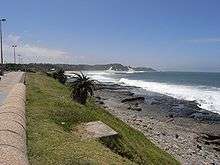
Points of interest
Transport
East London is serviced by two national roads: the coastal N2 highway connects it to King William's Town, Port Elizabeth and Cape Town to the west and Mthatha and Durban to the east. It is the southern end of the N6, which runs north via Komani and Aliwal North to Bloemfontein. Older sections of the N2 have been renumbered the R102. The R72 is an alternative route to Port Elizabeth, via Port Alfred. The R346 is an alternative route to King William's Town. East London, like South Africa's other major cities, uses Metropolitan (or M) routes as a third tier for its major intra-city roads.
East London railway station offers long-distance passenger services to Cape Town and Johannesburg via Springfontein, and local services.
East London Airport is a commercial airport with service to other large South African metropolitan areas.
Notable people
- Anthony Clifford Allison (1925–2014) was a South African geneticist and medical scientist, study on the genetic resistance to malaria[19]
- Lana Marks – South African-born American fashion designer and current United States Ambassador to South Africa
- Mark Andrews – Rugby player
- Wendy Botha – Four-time world surfing champion
- Mark Boucher – International cricketer
- Vuyani Bungu – Boxer
- Norman Catherine – Artist
- Marjorie Courtenay-Latimer – Museum curator
- The Dealians – Successful 1970s pop group
- Allan Gray – South African investor and philanthropist
- Joan Harrison – Swimmer and 1952 Olympic champion
- Rory Kockott – Rugby player
- Welcome Ncita – Boxer
- Makhaya Ntini – Test cricketer with over 100 caps for the South African national team
- Steve Palframan – Cricketer
- Ian Scheckter – Racing driver
- Jody Scheckter – Formula 1 racing champion in 1979
- Jonty Skinner – Swimmer and US swimming coach
- John Gordon Sprigg – Prime Minister of the Cape Colony
- Wayne Taylor – Racing driver
- André Vos – Rugby player
- Donald Woods – Author and anti-apartheid activist/born in Transkei
- Jean-Michel Byron - Singer who sang with American rock band Toto in the 1980s
- Jacob Maliekal - National badminton player who represented South Africa at the Rio Olympic Games in 2016
- Wouter Wessels - Senior FF+ politician
- Hlomla Dandala - A notable South African actor and television personality
Coat of arms
The East London municipality assumed a coat of arms on 29 August 1892.[20][21] The arms were : Argent, a cross Gules between in the first and fourth quarters a garb and in the second and third quarters a fleece Or; on a chief Azure a demi-sun Or. A golden anchor was placed behind the shield, no doubt to show that the town was a seaport. The motto was Animo et fide.
The arms were improved in the 1950s by the town clerk, H.H. Driffield. He changed the shield from silver to ermine, removed the anchor and devised a crest consisting of two crossed anchors and a mural crown. Heraldist Ivan Mitford-Barberton added two buffalo as supporters.[22] The improved design was granted by the College of Arms on 15 December 1959. It was registered with the Cape Provincial Administration in 1960,[23] and at the Bureau of Heraldry in 1967.[24]
References
- "Chronological order of town establishment in South Africa based on Floyd (1960:20–26)" (PDF). pp. xlv–lii.
- "Main Place East London". Census 2011.
- "South Africa Cities". Wwp.greenwichmeantime.com. 15 April 2011. Archived from the original on 14 May 2011. Retrieved 15 May 2011.
- Census 2011 — Metropolitan Municipality “Buffalo City”. Census2011.adrianfrith.com. Retrieved on 18 October 2015.
- The Story of the British Settlers of 1820 in South Africa – H. E. Hockly (Juta & Co., 1948)
- Burman, Jose (1984). Early Railways at the Cape. Cape Town. Human & Rousseau, p.81. ISBN 0-7981-1760-5
- Bond J.: They were South Africans. London: Oxford University Press. 1956. Chapter 19, The Makers of Railways: John Molteno. p.170.
- "Historical Highlights". The South African Institute for Aquatic Biodiversity. 14 September 2008. Archived from the original on 18 September 2008.
JLB Smith, a Chemistry Professor at Rhodes University, publishes his description of Latimeria chalumnae
- The Making of Territorial Apartheid : The Case of East London's Locations (PDF). Retrieved 29 November 2017.
- Mdantsane (PDF). Retrieved 29 November 2017.
- "Climate data for East London". South African Weather Service. Archived from the original on 4 March 2012. Retrieved 7 March 2010.
- "East London Historical Weather Records". TuTiempo.net. Retrieved 25 February 2012.
- "East London Climate Normals 1961–1990". National Oceanic and Atmospheric Administration. Retrieved 29 November 2013.
- "Klimatafel von East London (Oos-Londen), Prov. Eastern Cape / Südafrika" (PDF). Baseline climate means (1961–1990) from stations all over the world (in German). Deutscher Wetterdienst. Retrieved 7 February 2016.
- "Buffalo Regatta". 9 August 2016.
- Surf ski
- "toughest surf ski race in the world spans 155 miles of the South African Coast". 22 March 2017.
- "(2015 ☆ ARCHIVED) Oscar Chalupsky - South Africa | 2018 Nominees | World Paddle Awards | The Global Awards for Canoe, Kayak and other Paddlesports". www.worldpaddleawards.com.
- "Anthony Allison". Legacy.com.
- Western Cape Archives : East London Municipal Minutes (29 August 1892)
- Daily Despatch (31 August 1892).
- Western Cape Archives : files 3/ELN 1587 (50/1151) and 1783 (1151/1).
- Cape of Good Hope Official Gazette 3040 (5 August 1960)
- "National Archives of South Africa (NASA) Database Selection". www.national.archsrch.gov.za.
External links
| Wikimedia Commons has media related to East London, Eastern Cape. |
- Official website of Buffalo City

- East London
.svg.png)